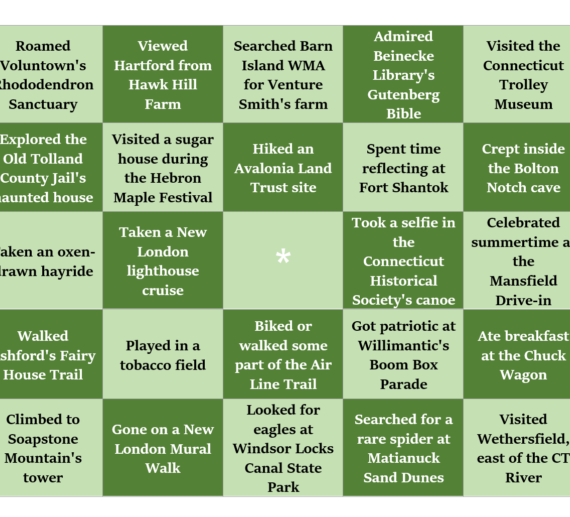“I learned that people do genuinely want to help and be a part of something greater than themselves. I learned that many people want to do the right thing for the Earth — they just need that extra little push, and need to see someone else do it first. I learned that positivity tends to create more positivity, as does goodness.”
-Robin Greenfield, in “Dude Making A Difference”

It is not a small point about people needing to see behavior modeled to know what is possible.
Those who live in an echo chamber and/or make no effort to seek examples of different ways of living are prone to declaring what is unfamiliar to them as being impossible.

Statements I have heard said with confidence that are untrue:
- You can’t live without a car in America
- You can’t live without a car in Connecticut
- You can’t get groceries without a car
- Nobody cares about traffic violence
- Nobody is doing anything to stop traffic violence
- Nobody is doing anything about climate change
- Mixed-use housing is illegal everywhere
- Multi-family housing is illegal everywhere

If you laughed at even one of those claims, I feel like I did my job for the day.
The assertion about climate change is one that rattles climate scientists, many of whom have written about exactly this and the daily work that they are doing on the problem. Exaggeration gets us nowhere, except more firmly stuck in a cynical cycle where we feel comfortable saying things like “the world is shitty and nobody cares.” You’re part of this world, honey. Do a thing.
The claims about housing are also, exaggeration, and fed by those who are thoroughly soaked in suburban living — apparently never venturing into cities or befriending those in urban environments where we can tell you, actually my friend, our zoning code is decent. We have other issues with housing, like how to get absentee landlords to improve living conditions, but we actually have lots of the basics down. Instead of wasting the days spreading “this kind of housing is illegal in America” memes, these folks could be asking their town’s Planning & Zoning Commission to address the issue, where and when it is an issue.
And the fact that Connecticut has 169 towns is not an excuse for an individual who cares about such things to choose not to take action, thinking they should just be able to reform this statewide and be done with that. Sure, push that lever if you feel like it, but there is a place where you are more likely to make change in a shorter amount of time, so just do it.

It is disheartening, though, to hear the types of statements claiming nobody is doing anything about particular issues or that nobody cares. [Side note: if I’m mentioning something that I’ve heard, I don’t need individuals emailing me because they think it’s about them. If it’s being mentioned, I’ve heard it multiple times from multiple sources who quite possibly do not know each other.]
People tell me this about traffic violence, that nobody cares.
It feels like a slap in the face because I am literally a person standing here caring and doing something about it.
I can name more than a dozen people, rapid fire, who are in Connecticut caring and doing something about this when they are not paid to do so. From my involvement, I know — regardless of what the media chooses to cover or not — that people are caring.
Caring may look like someone pressing their town for affordable housing around train stations. It looks like Fairfield residents pushing for the Livable and Safe Streets Ordinance, as they prioritize both saving lives and improving the quality of life in their town. It looks like paying attention to unsexy things like developers wanting to add driveways in an area with lots of foot traffic, and then responding to it.
I’m not sure what “caring” would look like to the folks who say that nobody cares, but I see plenty of evidence of caring.
Could more people be involved? Yes. Could we have wiser decision-makers in every level of government? Yes.
When I shared the piece about composting in New York, I got a lot of response (which I’m grateful for but when it comes through in emails, DMs, and in various places across social media . . . this means that I am aware of the discussion, but because it’s not happening in the comments right here, other readers do not get to partake. Y’all, stop being weird about using the Internet, be willing to put your name out there, and claim your opinions.).
The response was awesome. So many people were not aware of New York’s composting efforts, and ended up asking exactly why their towns hadn’t managed it yet. I’m willing to guess that many are in places where their towns were tiptoeing into some kind of program where residents have to drop off their scraps, and that seemed pretty good until they heard of another option.
The point was not that we should all mimic New York exactly, but that there is much more our own towns and cities could be doing, but aren’t. It’s helpful to show decision-makers examples of what others have managed to do.
And it’s helpful to show individuals that there are other ways of living than what our mainstream culture mirrors back at them, all the time.
This is why I talk so much about what it’s like for me to live car-free in Connecticut. I get told it’s impossible, while I am doing the “impossible” thing. I want people to understand that it actually is an option, and not only under very narrow conditions, and that this is not something I invented or perfected — I live in a neighborhood where 30-40% of residents do not have regular access to a private vehicle. Because there were people all around me moving about without relying on a car, I was not able to pretend that being car-free was not a reality outside of Manhattan.
It takes me less than five minutes to walk to the Park Street bus, which can take me to downtown Hartord or the West Farms Mall. Either way connects me with other bus routes, covering much of Greater Hartford. In less than two minutes I can walk to the Hillside Avenue bus, which can take me to downtown Hartford or to the Walmart plaza, which is a quick walk from a CTfastrak station; this then connects me to New Britain. From my house, I can easily reach a CTfastrak station, other local buses, and several express buses. There’s also the train nearby. I do not live in an expensive apartment for any of this to be possible.
I have the access without the worry over storage, annual taxes, registration, finding a mechanic, and any of the other costly nuisances of owning a private vehicle.
In Hartford, I can walk to numerous grocery stores and one of those fetishized “full service supermarkets”, which I rarely go to because the produce actually isn’t all that. I can get to numerous grocery stores by taking one bus without needing to transfer.
I recognize that not everyone in Hartford has this access, and to me, that’s a call for better bus service in certain neighborhoods. Nobody should need to transfer buses to buy apples and bread. It is also a more immediate fix to improve the bus service. We have been trying to figure out grocery stores for decades in certain parts of Hartford, but without much effort to assist residents in those transit-weak neighborhoods in the meantime. It feels so backwards to not do that while everyone scratches their heads over how to get someone willing to invest in parts of a neighborhood where there was active disinvestment for decades. This isn’t an either/or. It’s more of a what can we do in the near future, and then what can we do in a few years.
Talking about the way in which transit and pedestrian infrastructure can be improved is not the same as saying that living car-free is inherently a hardship.
For those who are considering how they can go car-free or use their cars much less, I definitely welcome logistical questions. I don’t have all the answers, but between my own experiences and what I have heard from friends, there’s plenty that can be shared. No need to make your own mistakes when someone else has already made them. Genuine curiosity is great. Bring it. Gotcha questions, like “Oh yeah, well that’s all good until winter” will be answered by me pointing to a regular series I wrote the last time someone thought to trot that out.
We learn from others, and we need to vary our sources of information. If we’re only ever looking at those within our own generation or those living in our zipcode, or only getting our news from one source, we’re limiting ourselves in how we understand the world. This benefits those who value sameness, but sameness is not healthy. Climate scientists have been saying as much: we need diversity in nature and we need diversity in people.
Climate Possibilities is a series about climate mitigation, along with resilience, resistance, and restoration. It’s about human habitat preservation. It’s about loving nature and planet Earth, and demanding the kind of change that gives future generations the opportunity for vibrant lives. Doomers will be eaten alive, figuratively. All photographs are taken in Hartford, Connecticut unless stated otherwise.




Richard Nelson
Hi Kerri One issue you brought up is dear to me.
I really don’t understand people who think “it” can’t be done without a car. Both my spouse and I have never driven a car. Yeah, he tried once when he was in Vietnam driving the garbage truck and knocked down the officers hootch. Couldn’t for the life of him steer while swilling gin, escaping the horrors that uncle scam brought to the young men and to the people of Vietnam.
May I say I find the excuses that folks have to be absurd and at 75 and 77 we both just shake our heads. Winter we just go. Summer with the heat and mosquitos biting we just go. Rain, sleet, sunshine, nighttime, and snow, go man go. To the grocery store go with the cart, to the hardware store, go with the cart, (you even have a photo of Tim coming home with plywood on the cart,) heavy duty shopping cart presents no problems for us, jump on the bus and walk home, and we now live in so called suburbia. He takes the bus downtown to work. I have to say sometimes I miss Hartford and all of the bus routes that we could take our pick of but in these parts one can do it with a little thought and planning. Just another part of the day to day.
Before coming to Hartford, I lived in West Hurley NY 10 miles outside of Woodstock. Way up the mountain. How did I get to town. Outdoor Billy showed me the short cut over and down the mountain. Wintertime, stock up your pantry, and I found that most of the time I really didn’t need to go to town for supplies or if I needed to go for some, for fun, games, or something good I jumped on the bus as it passed Maverick Road, stayed overnight with a hot number I knew, and the next day took the bus back. Of course, at 30 one could do a lot more than at 75. Outdoor Billy used snowshoes to get over Ohayo mountain, but I never tried them. Thinking, planning, and knowing what you are doing and once one integrates this type of living into living your life it works quite well.
Will I still be doing this when I am 85, maybe, as I have lived my life without a car for at least the last 60 years. (I am already entertaining that notion of where and what in 10 years). But I am not pure, if you call me and say, “would you like to take a ride and get an ice cream cone”, I will say, “sure”. Or if the need arises of course I do ride in a car or taxi. I have been in a car 4 times this year so far. Perhaps as I have gotten older, but no wiser, my world has become smaller. But what is out there in the world most of the time just doesn’t interest me. My books, my writings, my home, my flowers in the garden, the birds and the bees and the coyotes howling is just enough. Of course, there is the fact of not being needful. Needful does indeed present a host of problems.